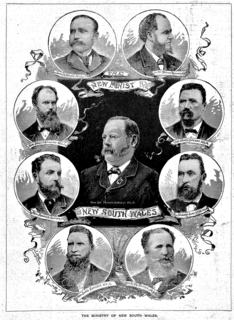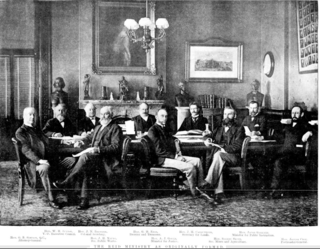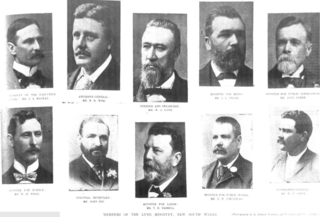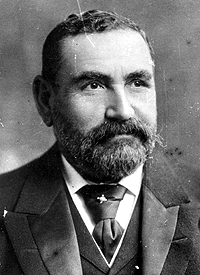
Sir George Richard Dibbs KCMG was an Australian politician who was Premier of New South Wales on three occasions.
Members of the New South Wales Legislative Assembly who served in the 11th parliament of New South Wales held their seats from 1882 to 1885.</ref> Elections for the eleventh Legislative Assembly were held between 30 November and 21 December 1882 with parliament first meeting on 3 January 1883. The Assembly was expanded to 113 members elected in 40 single member electorates, 26 two member electorates, 3 three member electorate and 3 four member electorates. The parliament had a maximum term of 3 years and was dissolved on 7 October 1885 after 33 months. The Premiers during this parliament were Sir Alexander Stuart until 7 October 1885 and then George Dibbs. The Speaker was Edmund Barton.
The Donaldson ministry was the first ministry of the Colony of New South Wales, and was led by Stuart Donaldson. Despite the first free elections for the New South Wales Legislative Assembly being held in March 1856, it took over two months for Donaldson to form Government. It was sworn in on 6 June 1856, after the 1856 election and lasted just eighty days.
The second Cowper ministry was the fourth ministry of the Colony of New South Wales, and second occasion of being led by Charles Cowper.

The third Robertson ministry was the fifteenth ministry of the Colony of New South Wales, and was led by John Robertson. It was the third of five occasions that Robertson was Premier. Robertson was elected in the first free elections for the New South Wales Legislative Assembly held in March 1856.

The third Parkes ministry was the nineteenth ministry of the Colony of New South Wales, and was led by Sir Henry Parkes in a coalition with Sir John Robertson. It was the third of five occasions that Parkes was Leader of the Government.
The first Dibbs ministry was the 21st ministry of the Colony of New South Wales, and was the first of three occasions of being led by the Premier, George Dibbs. Dibbs was elected to the New South Wales Legislative Assembly in 1874.

The Jennings ministry was the 23rd ministry of the Colony of New South Wales, and was led by the eleventh Premier, Sir Patrick Jennings, and the first Roman Catholic to hold the office of Colonial Premier. Jennings was first elected to the New South Wales Legislative Assembly at the 1869–70 election, and then again in 1880.
The fourth Parkes ministry was the 24th ministry of the Colony of New South Wales, and was led by the seventh Premier, Sir Henry Parkes. It was the fourth of five occasions that Parkes was Premier.

The fifth Parkes ministry was the 26th ministry of the Colony of New South Wales, and was led by the seventh Premier, Sir Henry Parkes. It was the fifth and final occasion that Parkes was Premier. The title of Premier was widely used to refer to the Leader of Government, but was not a formal position in the government until 1920. Instead the Premier was appointed to another portfolio, usually Colonial Secretary. Having served in the New South Wales Legislative Council between 1854 and 1856, Parkes was elected in the first free elections for the New South Wales Legislative Assembly held in 1856, however resigned from Parliament later that year. He served in the Assembly on several occasions, between 1858 and 1870, being forced to resign on 4 occasions due to his personal insolvency. He came to power as Premier on the first occasion in 1872, serving as Premier for a period of three years. However, Parkes lost the confidence of the Assembly following Governor Robinson's decision to release of the bushranger Frank Gardiner led to the defeat of the ministry in 1875.

The second Dibbs ministry was the 25th ministry of the Colony of New South Wales, and was the second of three occasions of being led by the tenth Premier, George Dibbs. Dibbs was elected to the New South Wales Legislative Assembly in 1874. In a period of great financial stress for the Colony, this ministry covers just 49 days from 17 January 1889 until 7 March 1889. Dibbs took over as Premier on the first occasion in October 1885 following resignation of the Alexander Stuart due to ill-health, with his ministry lasting for 75 days. Dibbs served as Colonial Secretary in the Jennings ministry, before it too suffered budgetary pressures. It was during this time that the party system was formed in New South Wales with Sir Henry Parkes leading the Free Trade Party. Dibbs had been elected as an independent free trader, however his opposition to Parkes caused Dibbs to align himself with the Protectionist Party. Dibbs had assumed office when Parkes lost a vote on the floor of the Assembly. Parliament was dissolved on 19 January 1889 and an election was held in February. There was a significant swing to the Protectionists, gaining 29 seats, however it was insufficient to command a majority of the Legislative Assembly and Parkes resumed the premiership.

The third Dibbs ministry, the 27th ministry of the Colony of New South Wales, was led by Sir George Dibbs, leader of the Protectionist Party, following the 1891 New South Wales election, which saw the Labour Party win seats in the New South Wales Legislative Assembly and the balance of power. With no party having a majority, Sir Henry Parkes held on as Premier until October 1891 when he lost a vote in the Legislative Assembly, causing Parkes to resign as Premier and leader of the Free Trade Party. Dibbs formed the ministry on 23 October 1891, with Labour support, and comprised 10 ministers.

The Reid ministry was the 28th ministry of the Colony of New South Wales, and was led by the 12th Premier, George Reid. The title of Premier was widely used to refer to the Leader of Government, but was not a formal position in the government until 1920. Instead the Premier was appointed to another portfolio, usually Colonial Secretary but on this occasion Reid took the portfolio of Colonial Treasurer until July 1899 and then Attorney General.

The Lyne ministry was the 29th ministry of the Colony of New South Wales, and was led by the 13th Premier, Sir William Lyne, KCMG.

The See ministry was the 30th ministry of the New South Wales Government, and was led by the 14th Premier, Sir John See. The title of Premier was widely used to refer to the Leader of Government, but was not a formal position in the government until 1920. Instead the Premier was appointed to another portfolio, usually Colonial Secretary.
Members of the New South Wales Legislative Council who served from 1882 to 1885 were appointed for life by the Governor on the advice of the Premier. This list includes members between the elections commencing on 30 November 1882 and the elections commencing on 16 October 1885. Cox died, Bell died, Abbott & Gordon appointed, Dangar & Jacob appointed, Neale appointed, Ryan appointed, Holt resigned, Blaxland died, Alderson died, Frazer died, Docker died, Levy died, Marks died, 8 appointed, Joseph resigned, J Smith died, Stuart & Farnell appointed. </ref></ref> The President was Sir John Hay.
A by-election was held for the New South Wales Legislative Assembly electorate of East Sydney on 29 February 1884 as a result of the Legislative Assembly declaring the seats of Francis Suttor, and George Reid, were vacant as a result of a report of the Committee of Elections and Qualifications that they were incapable of being elected, or of sitting, or voting, as a member of the Assembly.
A by-election was held for the New South Wales Legislative Assembly electorate of Newtown on 13 January 1883. The election was triggered by the appointment of Henry Copeland as Secretary for Public Works in the Stuart ministry.
East Sydney, an electoral district of the Legislative Assembly in the Australian state of New South Wales was created in 1859 and abolished in 1894.
A by-election was held for the New South Wales Legislative Assembly electorate of East Sydney on 11 January 1883 because George Reid was appointed Minister of Public Instruction in the Stuart ministry. Such ministerial by-elections were usually uncontested and six ministers were re-elected unopposed. On this occasion a poll was required in East Sydney and Newtown. Copeland was defeated but regained a seat in parliament at the second by-election for East Sydney held on 23 January 1883. The six other ministers, Alexander Stuart (Illawarra), George Dibbs, Henry Cohen, James Farnell, Francis Wright (Redfern) and Joseph Abbott (Gunnedah), were re-elected unopposed.












